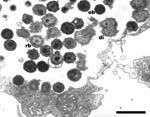Phylum Chlamydiae | Class Chlamydiae Rank Family | |
 | ||
Similar Chlamydiales, Waddlia, Chlamydophila abortus, Chlamydiaceae, Chlamydia muridarum | ||
Parachlamydiaceae is a family of bacteria in the order Chlamydiales. Species in this family have a Chlamydia–like cycle of replication and their ribosomal RNA genes are 80–90% identical to ribosomal genes in the Chlamydiaceae. The Parachlamydiaceae naturally infect amoebae and can be grown in cultured Vero cells. The Parachlamydiaceae are not recognized by monoclonal antibodies that detect Chlamydiaceae lipopolysaccharide.
Parachlamydiaceae species currently include:
Isolated Endosymbionts include:
Uncultured lineages include:
Parachlamydia acanthamoebae has variable Gram staining characteristics and is mesophilic. Trophozoites of Acanthamoeba hosting these strains were isolated from asymptomatic women in Germany and also in an outbreak of humidifier fever (‘Hall’s coccus’) in Vermont USA. Four patients from Nova Scotia whose sera recognized Hall’s coccus did not show serological cross-reaction with antigens from the Chlamydiaceae.
